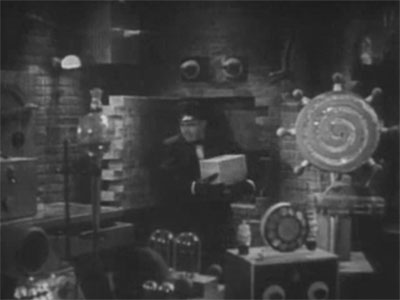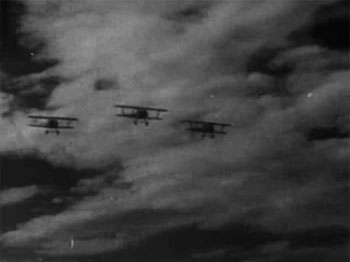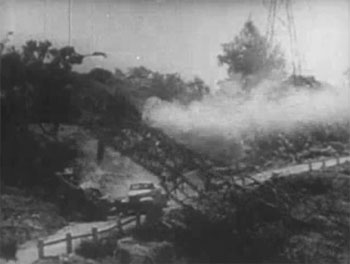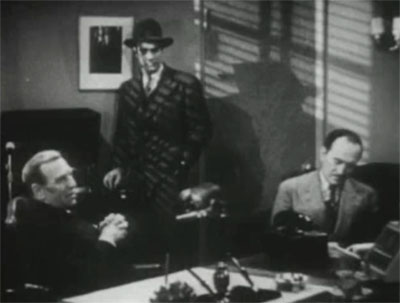
Universal, 12 Chapters, 1939. Starring Bela Lugosi, Robert Kent, Dorothy Arnold, Jack C. Smith, Edwin Stanley, Regis Toomey, Edward Van Sloan, Anthony Averill.
By utilizing the scientific properties of minerals contained in a unique meteor fragment, the brilliant but unbalanced Dr. Alex Zorka (Bela Lugosi) has developed an array of astonishing and dangerous scientific weapons. Zorka’s wife Ann (Dora Clement) and his former colleague Dr. Mallory (Edwin Stanley), alarmed by the lethal nature of these inventions, and disturbed by Zorka’s talk of selling them to foreign powers, try to convince him to either abandon his researches or turn his discoveries over to the US government. The megalomaniacal Zorka refuses to listen to them, and disappears after faking his death when Mallory alerts Captain Bob West (Robert Kent) of the Department of Military Intelligence to his dangerous activities. Zorka tries to arrange for his wife to join him in hiding, but causes a plane crash that results in her death; holding his “enemies” responsible for the disaster, he determines to take his revenge on them and the rest of the world. However, his plans are soon hampered by the foreign spy ring that had hoped to buy his inventions and by West’s squad of DMI agents; spies and Intelligence officers are soon engaged in a duel over Zorka’s priceless meteorite fragment, while the mad doctor tries to retain (or, alternately, regain) control of his power source–with the aid of his mechanical spiders, his Z-ray (both of which put their victims in a state of suspended animation), his intimidating giant robot, his invisibility device, and (last and least useful) his reluctant assistant, the escaped convict Monk (Jack C. Smith).

Above: Zorka transforms into the invisible Phantom of the serial’s title.
The Phantom Creeps begins quite strongly, individualizing its central villain and giving him a memorably dramatic “origin” in the serial’s first two chapters. However, its narrative becomes much more ordinary in Chapter Three, in which the three-way struggle for control of the meteorite fragment begins; this struggle sidetracks Zorka’s plans of vengeance until the final chapter, when he belatedly begins wreaking havoc on the world at large. While this ongoing battle for the meteorite does keep Creeps moving at an enjoyably swift pace, it’s dragged out for far too long; by Chapter Seven the pursuit of the fragment has become so noticeably repetitious as to make the serial’s remaining episodes (save the final one) seem rather like a pointless exercise in wheel-spinning–particularly when the leaders of the spy ring are abruptly and undramatically written out early in Chapter Twelve, which clears the way for Zorka’s exciting climactic rampage but also emphasizes the fact that the spies have really filled no function in the plot beyond providing narrative padding. Had the serial’s characters been stronger–like those who engaged in a similar tug-of-war in Red Barry–the repetitiveness would have been less of a problem, but both the Military Intelligence heroes and the villainous foreign agents are given rather sketchy personalities; only Zorka, and to a lesser extent Monk, are really individualized.

Above: The untrustworthy Monk perpetrates the first of many thefts of the meteorite fragment.
Creeps’ thin and overstretched screenplay is credited to George Plympton, Basil Dickey, and Mildred Barish, while Wyllis Cooper is listed as the author of the serial’s “story.” Cooper, a radio writer and producer who specialized in horror and mystery tales, has no other chapterplay credits, but was one of the writers of the A-feature Son of Frankenstein, which was released by Universal earlier in 1939 and featured Creeps’ star Bela Lugosi in a major role that temporarily restored him to horror-movie prominence after a three-year hiatus from the screen. It seems reasonable to assume that Universal hastily assigned Cooper to concoct a serial vehicle for Lugosi after the success of Son of Frankenstein; the basic plot that Cooper came up with would have worked well in half-hour format on the airwaves (the fate of Zorka’s wife is a typical radio-style ironic twist), but wasn’t able to sustain a twelve-chapter serial on its own.
Speaking of Lugosi, there are many indications in Creeps that Universal’s serial-making team regarded the serial as more or less presold by the presence of the great horror-movie star–and felt free to skimp on other aspects of production. The serial’s weak storyline has already been touched on; it’s also somewhat lacking in the action department. Fistfights are few and far between, and are short when they do occur; the brawl in the motorboat in Chapter Nine and the concurrent fights (between the hero and the spies and between Zorka and a railroad switchman) in Chapter Ten are the only fight scenes that go on for any length of time–and they’re quite routine, despite the presence of Dave Sharpe and Tom Steele. Gun battles are even more scarce, and generally very brief–like the confrontation at the foggy airfield in Chapter Four (which is, however, very well-shot). Car chases and aerial clashes are more common than fights or shootouts in Creeps, and are generally well-done, although they draw heavily on stock footage; the heroes’ aerial attack on the villains’ car in Chapter Five, the plane assault on the villains’ ship in Chapter Seven (borrowed mostly from The Phantom of the Air), and the final airborne showdown between Zorka and the Intelligence men are all cases in point.


Above: Army planes fly in to stop a demented Zorka’s destructive spree in the serial’s climatic sequence.
Stock footage is frequently used in other parts of Creeps, particularly in the chapter endings; the huge fire sequence featured in the 1933 Perils of Pauline (but obviously culled from an even earlier source) serves as the cliffhanger for Chapter Eight–and is just as unconvincingly melded with the new footage, and as unbelievably resolved, as it was in Pauline. The highway blasting-crew sequence from The Vanishing Shadow is also utilized, rather awkwardly, to close Chapter Eleven. However, other chapter endings, though almost certainly drawn from stock footage, are much more effectively blended into the serial–and are quite memorable; the cliffhanger for Chapter Two (which has towering pylons toppling down onto the hero’s car) and the ending of Chapter Seven (which has the hero’s plane crashing into a dock) are particularly excellent. The best of the serial’s chapter endings, however, is one of the few ones consisting of all-new footage–the conclusion to Chapter Six, which has the hero being attacked and apparently crushed by Zorka’s frightening robot.




Above, top left: the pylon-toppling ending to Chapter Two. Top right: the hero’s plane about to crash into a dock to end Chapter Seven. Bottom left and right: the robot attack cliffhanger in Chapter Six.
The aforesaid robot, though decidedly intimidating (being played by seven-foot-plus actor Ed Wolff) has few moments in the spotlight aside from the Chapter Six cliffhanger; it generally remains in the background and has less to do than the mechanical men in The Vanishing Shadow or Mysterious Doctor Satan. The robot does get to periodically terrorize Monk, and make two brief but enjoyable attacks on the spies; its final encounter with the Army, however, is cut short in frustratingly anticlimactic fashion. Other gadgets receive more exposure, and do much to enliven the serial; the mechanical spiders that “bite” Zorka’s enemies and send them into comas are surprisingly creepy (despite being small props obviously pulled on wires), while the discs that Zorka uses to draw them to their unwitting victims make for some good suspense sequences–particularly the scene aboard the plane in Chapter One, which has the protagonists casually passing around one of the discs as an unobserved spider moves towards them. Zorka’s invisibility belt is the same one seen in Vanishing Shadow; as in that serial, the effects used to depict the materialization and de-materialization of the belt’s wearer are handled very convincingly. The weird props that fill Zorka’s lab–many of them recognizable from the Flash Gordon serials–provide impressive support for the scientist’s principal gadgets.


Above: Reporter heroine Jean Drew (Dorothy Arnold) searches Zorka’s dark mansion (left), unaware that she’s carrying a disc that’s drawing one of the mad scientist’s “spiders” to her (right).
Zorka’s secret passages and his shadowy “abandoned” mansion are spookily and atmospherically filmed by directors Ford Beebe and Saul Goodkind, and by cameramen Jerome Ash and William Sickner; the foggy scenes at the airport (Chapter Four, mentioned above) and in the harbor (Chapter Seven) are also shot with style. Universal’s familiar dockyard set figures in the latter sequence; the serial’s other locations–indoor and outdoor–are backlot ones as well (the country roads seen in the car chase scenes are almost certainly a part of stock-footage scenes from earlier productions). The serial’s music score–composed of stock cues from Universal’s library, including many pieces from Son of Frankenstein–is generally effective, with the score veering from brisk to ominous when necessary; only the excessively chipper-sounding theme that accompanies bouts of bickering between hero and heroine seems out of place.

Above: A well-composed down-angled shot of Zorka lurking in his secret passage.
As aforementioned, Universal seems to have been relying principally on Bela Lugosi to sell Phantom Creeps–and Lugosi’s intense and commanding performance is indeed the serial’s biggest asset. His unique screen presence completely dominates the chapterplay—whether he’s sternly issuing orders to Monk, making grimly sarcastic remarks, delivering crazed rants about ruling the world, smugly and arrogantly demonstrating his inventions, growling furiously at his enemies and his henchman, indulging in maniacal laughter, or movingly reacting to his wife’s death.

Above: Bela Lugosi proudly demonstrates his “Z-ray” for the nervous Jack C. Smith.
Lugosi’s co-stars are a capable lot, but much less charismatic than the top-billed villain. Robert Kent as Captain Bob West makes a solid if not particularly dynamic hero; his doggedly determined manner and gruff but calmly self-assured manner are well-suited to his quasi-military character. Dorothy Arnold is able to keep reporter heroine Jean Drew from seeming obnoxious–despite her habit of shadowing the hero everywhere without authorization; however, while her down-to-earth, slightly hard-boiled characterization is a welcome change from the brashness and shrillness of other filmic girl reporters, it doesn’t provide much of a contrast to Kent’s similarly low-key performance. First-rate character actor Regis Toomey is a welcome presence as Kent’s tough and reliable right-hand man Lieutenant Daly, tossing off sardonic remarks with his usual aplomb–although his no-nonsense performance, like that of Arnold, is rather similar to Kent’s.


Above left: Robert Kent and Dorothy Arnold examine a clue. Above right: Regis Toomey drives Edwin Stanley to Lugosi’s lab.
Edwin Stanley is very good as Dr. Mallory–conveying genuine regret over the behavior of his former friend Zorka, grave concern over the potential misuse of Zorka’s inventions, and shrewd thoughtfulness as he concocts ways and means of countering those inventions. Jack C. Smith plays delightfully off Lugosi as the grumbling, cowardly, and frequently rebellious Monk. As in The Oregon Trail, the juxtaposition of his gravelly voice and his unimpressive appearance makes him seem like a comically pathetic blusterer; his clumsy attempts to deceive Zorka or otherwise revolt against the tyrannical scientist are darkly amusing. Dora Clement is sympathetic in her brief turn as Zorka’s understandably perturbed wife.
Edward Van Sloan–Lugosi’s nemesis in Dracula–has relatively little screen time as spy-chief Jarvis (and never shares a scene with Bela), but his characterization–smirkingly cheerful and curtly authoritative by turns–is quite enjoyable. Anthony Averill, a former Warner Brothers B-film player, is slick but rather bland as Van Sloan’s henchman. Subordinate members of the spy ring are played by Karl Hackett, Forrest Taylor, Jerry Frank, Robert Blair, and Monte Vandergrift; James Farley, Lane Chandler, Al Bridge, and Hooper Atchley have much smaller roles as other agents of the ring. Incidentally, the “masks” the spies don from time to time are by far the serial’s most poorly-realized gimmick; the heavies make a show of putting on rubber full-face coverings, but then drop the real masks in favor of mere false mustaches and eyebrows that they (and the other characters) pretend are part of the “mask” (presumably to make dialogue easier).

Above: Edward Van Sloan dictates a coded message to Karl Hackett, as Anthony Averill waits to report in the background.
Eddie Acuff is given a few moments in the spotlight (both comic and serious) as one of Robert Kent and Regis Toomey’s two principal assistants; the other backup Intelligence operative (who has less screen time than Acuff) is played by none other than Roy Barcroft. Pat O’Malley appears as the Military Intelligence chief, congratulating our heroes in the final chapter. British-accented Hugh Huntley is Edwin Stanley’s research assistant, Reed Howes an airport mechanic, Monte Montague a railroad switchman, Charles King a policeman, Dave Sharpe a sailor, and Tom Steele an Intelligence agent. Lee J. Cobb appears–but only in stock-footage form–during a sequence borrowed from The Vanishing Shadow.
The Phantom Creeps‘ plotting inadequacies, the infrequency of its action scenes, its general lack of character touches, and its heavy use of stock footage would not have constituted really damaging flaws singly, but in combination they make the serial perhaps the weakest of Universal’s cliffhanger efforts from the studio’s 1936-1940 period. However, it’s far from unwatchable, and is frequently enjoyable–thanks to its effective pacing, its colorful array of scientific gimmicks, and a larger-than-life performance by the inimitable Bela Lugosi.

Above: Lugosi shares a heartfelt moment with his robot (“You will be the instrument of my vengeance!”)
You can’t do a review of THE PHANTOM CREEPS without mentioning Jack C. Smith’s role as Henchman, Monk. He is even more incompetent than the villains in a James Horne serial. However, Smith was much more effective as Bull Bragg in THE OREGON TRAIL.
Excellent background piece on this Lugosi serial.
Wish we had an original Universal print of this serial on bluray.
The Commonwealth Pictures version seems to be the only survivor in existence.
The VCI DVD appears to be the best source to enjoy this foray into Zorka Land.
While hoping against hope that Universal Home Video would reclaim this serial and produce a high quality DVD (even a bluray?)…even finding an original print with Universal titles, as opposed to the Commonwealth Pictures titles…..the question is: What vendor has the best quality DVD of this title?
Is it VI or Grapevine Video…or someone else?
I haven’t seen the Grapevine one, but I can’t imagine it’s any better than the VCI–which is very good, light-years better than any of the gray-market prints of Phantom Creeps. Amazon has a sample of the VCI version if you want an idea of the quality (I did this review before I got the VCI DVD, so the screen-grabs I used are not of the best quality; I really need to replace them one of these days).
I got the Grapevine Video version.
It’s 2 dvd…and pretty good quality.
I am trying to track down an original VCI version dvd, before they began producing dvd- r that they now sell.
Lugosi, a truly incredible and very unique robot, and not too much else. The serial takes off in the last chapter, when Bela finally becomes truly unhinged, but the rest of it is a very round and round chase for the precious meteorite, a storyline which is more than a little tedious as the narrative progresses. The cast is interesting and varied, and I absolutely loved Jack C. Smith’s performance as the incredibly put-upon Monk. I lost track of how many times he was shot, with seemingly little effect. As you rightly observed, the one is both watchable and very frequently enjoyable.